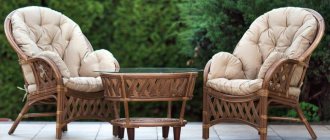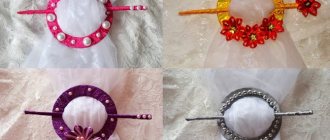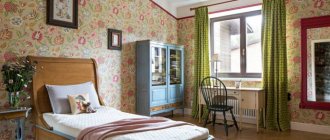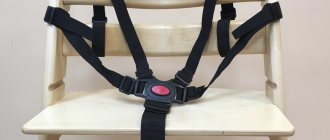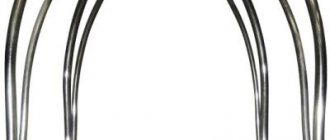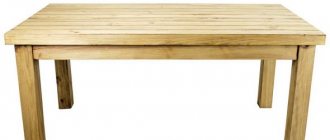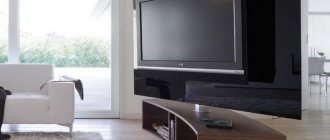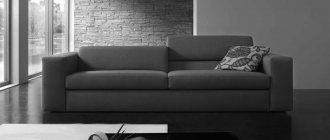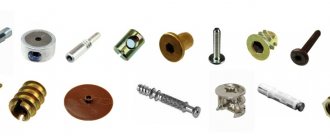Modern floor coverings are durable and beautiful. But expensive dies of laminate, parquet, and soft linoleum can be deformed under the influence of furniture legs. The massive sofa presses through the linoleum, the chair leaves scratches. To get rid of unpleasant marks, home craftsmen use many means. Let's look at simple ways to fix the problem yourself.
Work algorithm
To protect the flooring, you need “shoes” for the legs of the chairs. It is made from different materials according to a preliminary pattern. The pattern is made like this:
- draw a circle around the leg on a piece of paper;
- up to 0.3 cm allowance is added to the diameter size;
- this indicator is taken as a basis.
The allowance is needed to adjust the position of the overlay. In addition, materials tend to wear out, shrink and expand. If there is no allowance, the pad will settle during use, exposing the edges of the chair leg.
What to make overlays from
There are an incredible number of options for making “shoes” for chair legs:
- “Socks” are knitted from leftover yarn. This touch will add originality and aesthetics to the interior. Covers can be of any length, color and texture. The thicker the base, the longer the floor will remain intact.
- A piece of felt and a cord. Wrap the material around the leg and tie it with a lace – it looks stylish and unusual. On thick legs, the lace is passed through holes in the felt, and the lacing is tied with a knot. Use thin felt to make it easier to wrap the leg.
- Rounds made of thick felt. Leftover felt boots will do. Round pads are cut out of the boot exactly to the size of the base and glued with quick-drying glue.
- Thick drape. An old coat or a belt from it can be found in any home. This will make a ton of spacers for furniture supports. Drape is also glued to moment and similar mixtures.
- A piece of felt. There are ready-made parts on sale with a felt bottom and short metal tubes. The tube is hammered into the chair leg, the lining is not glued, it fits tightly to the support. But you can do without a purchased part - stick a piece of felt on the leg and you're done.
- Wine cork. Cut the cork into round pieces the size of the chair legs and glue to the base. The cork should be glued with acetone. Drop solvent onto the material, the cork will begin to melt, at this moment immediately press it to the chair leg.
- Linoleum. Scrapping flooring material comes in handy in many ways, cutting out chair supports is one of them. Glue with superglue or linoleum glue. The adhesive mixture is made from small scraps of material - they are placed in a jar and filled with acetone. After a couple of days, the linoleum will melt and the glue is ready.
- Rubber stoppers for medicines. Turn the cork over so that the protruding parts are on the outside. Now the element is screwed on with a self-tapping screw, recessing the cap into the rubber. The ribs of the cork will reliably protect the floors from scratches and pressure.
An old magazine advised putting champagne corks on chair legs. Today, the advice is also relevant, and champagne corks are replaced with any other wine corks. The plastic covers fit securely onto the chair supports and do not slip off.
A useful life hack: to keep the backing on slippery or shaped legs, screw it in with a screw, recessing the cap as deep as possible into the body of the backing.
Manufacturing process
Upholstering the legs of chairs or stools is easy. This process does not require any special skills. You will need a piece of material chosen from the list above, scissors, a pencil, a ruler or tape measure, hot glue and a hair dryer or superglue. After measuring the legs in length and width, appropriate pieces are cut out of the material and installed on the legs using glue. After the glue has dried, the chairs can be used for their intended purpose.
Plastic pads are made using “hot technology” according to the instructions: thermoplastic balls are softened in hot water, after which they must be manually given the required shape and thickness, placed on the legs and wait until completely dry.
When choosing supports for chair legs, you need to proceed from the type of floor, furniture material and your preferences. In any case, the use of protectors will make the use of mobile furniture more comfortable.
What to glue and with what, so as not to scratch the laminate
Guys, what and with what do you glue on the legs of chairs to prevent the laminate from scratching? I tried linoleum with double-sided tape, but while everything is fine for cabinets, it is rarely moved, but it comes off the chair legs. Try to fasten it with a screw, I'm afraid the linoleum will ripple and it will only get worse. I saw special stickers on sale, but I’m afraid they, like double-sided tape, won’t hold anything in place. Share your experience.
Again, the moment-montage is the strongest! “Special stickers” do not fly off.
I glued felt rounds from the store to the legs of four chairs and a kitchen table, and they have held up for a year and a half so far. Some have slipped somewhat from their original position, but have not yet fallen away. The only inconvenience is that the legs have to be vacuumed individually - they collect a lump of dust.
wow! wrote: I saw special stickers on sale
Keep up well, but the room must be clean, otherwise it will be like mine, the apartment is being renovated, we drag sand from the corridor, these stickers quickly become clogged with sand and become like sandpaper and scratch the laminate
I cut round pieces from the belt of an old drape coat and glued them together for a moment. I pasted over everything I could, I often move the sofa - the legs are large in diameter and there are no pads.
Ikea sells these felt rounds mounted on short metal tubes with sharp edges. the tube gets stuck into the chair leg, and the round thing will never fall off
terrapevt wrote: the tube gets stuck in the chair leg, and the round thing will never fall off
When will the round be worn off?
It is convenient to glue thick, dense felt with contact glue.
yes, when is it still grinding? and then, the felt sits on some kind of denser substrate (that is, this tube is not just stuck into it). Ikea used to sell the same round ones on self-adhesive tape (they flew off quickly if there were people like me who liked to “ride” on a chair). and these have been holding on for a couple of months now.
terrapevt wrote: when will it still wear off?
terrapevt wrote: these have been holding on for a couple of months now.
2 months is not a long time. The main thing is to notice when they are worn down so as not to tear up the floor
Leroy sells plastic attachments for legs of different diameters, which are put on and nailed. We bought nailed brown ones, about 3 cm in diameter (there are different diameters and different colors). The chair and table roll beautifully on the floor and do not collect dirt, like all the “fluffy” stickers. It looks like a furniture nail with a huge head. Sold in sets of 12 pieces, I think.
Making socks for furniture legs with your own hands
If your sofa legs are scratching the floor or the legs of chairs, office chairs, armchairs, cabinets or other furniture, it's best to make your own furniture socks. This option is suitable for any room - kitchen, living room, bedroom or nursery and will add a touch of uniqueness to the furniture.
Materials for making socks
To prevent the chair from scratching the floor and leaving marks from other furniture, you can make special unique socks from the following materials:
- advanced yarn. Knitted socks can be worn on metal or iron legs of chairs, stools and other furniture. Depending on the desire of the craftsman, you can knit plain socks suitable for a classic interior or a multi-colored lining for finishing in High-Tech, Modern style, and so on;
Protective yarn pads for kindergarten
The stronger and thicker the base of the sock, the longer the product will protect the floor covering.
- any fabric. You can sew furniture legs from almost any material. The master also independently determines the shape of the protective cover and its dimensions. To give the sole strength, you can use any of the materials presented below;
Protective covers made of different fabrics
- had tried. From this material you can independently make standard padding for iron or metal legs (similar to protectors) or special socks with laces. Felt is one of the strongest and most durable materials compared to yarn, and with a little effort and imagination, you can make original supports for linings;
Felt lined socks with laces
- thick drapery or felt, which can be obtained from an old coat or a belt from outerwear. The covers are made according to a pattern (more about the rules for making a pattern below) and attached to the legs of the furniture using glue. Drape is a more durable material than yarn, and less durable than felt;
Protective pads for felt furniture legs
- wine cork A lid is cut out of the cork with a sharp knife to the shape and size of the furniture leg and pasted over with acetone, which dissolves the surface of the cork and increases the degree of adhesion to the leg. If a cabinet or chair scratches the laminate, one of the most acceptable solutions is a protective cork overlay;
Making a cork filling
- linoleum. If a chair scratches the laminate, you can cut out protective pads from the linoleum and glue them to the legs of the furniture. If an office chair on wheels scratches the floor, you can make a special protective compound from linoleum:
- linoleum is cut into small pieces and placed in an airtight container;
- the edges are filled with acetone for complete coverage;
- the mixture is infused for 2-3 days (until the linoleum is completely dissolved).
Adhesive for linoleum
Homemade linoleum scrap glue can be used to secure overlays made from materials as it is a great alternative to standard superglue.
Felt, felt, leather
The simplest option for attachments is felt or felt products. These materials can be purchased at any clothing store. After measuring the base of the leg, you need to transfer the shape to the material, cut out a piece and then glue it.
It is worth clarifying that these materials must be glued with hot glue. Cold gluing does not guarantee good adhesion and will most likely come off quickly. The hot glue will saturate the material.
Metal foot caps are often made from felt, drapery and felt. Of these materials, felt is considered the most durable.
Leather works great on hardwood or laminate floors, but can slip on carpet and tile. Rubber, especially dark rubber, can leave marks on both carpets and tiles.
Yarn
For wooden chairs, you can use lighter materials. Craftsmen use leftover yarn to make funny or elegant socks. Such products will fit perfectly into the interior of a children's room.
Wine corks
Wine cork tips can be made quickly and effortlessly. To do this, a piece 3-4 mm thick is cut out, after which it is carefully glued to the furniture leg. Remember that cork is ideal for stationary furniture. By the way, you can use acetone instead of glue. It dissolves the surface of the cork, providing the necessary grip on the stem.
Recommended: One eye, but many glasses: how to store them if there are no cases
Linoleum
Another convenient material for making chair leg supports is regular linoleum. Small repair scraps can be used both as a protective and as an adhesive.
In the first case, parts are cut out of linoleum in a shape that matches the base of the furniture legs. In the second case, the linoleum is cut into small pieces, poured with acetone so that the liquid completely covers the material, and left for three days. After 3 days, the linoleum coating will completely dissolve and a homogeneous mass with excellent adhesive properties will form.
To prevent furniture from scratching the floor. Ingenious but simple inventions of needlewomen
So, the most interesting and stylish options that will give your interior some charm, coziness and comfort.
A fun option for the Christmas holidays.
Soft pads: the owner placed foam rubber inside.
From multi-colored scraps.
Well, for those who know how to knit, the flight of imagination is simply limitless.
Multi-colored crochet tips.
Both on the seat and on the legs - in the same style.
Made from one yarn it looks original.
A sort of cat's paws.
Children's table and chair. The baby will be delighted.
Delicate wedding option.
Soft fabric lining.
Without hesitation, the hostess simply used tennis balls.
The idea was also picked up at school. Everyone brought four balls, now the classroom is quiet and the floors are intact.
Hard felt was used.
Socks-tips with cats.
Kitchen set made of fabric.
Spring flowers made of soft felt. Benefits and good mood are guaranteed to you.
What to do if chair legs scratch the floor: protective “socks”
“Socks” can be easily purchased in specialized stores or made with your own hands. Products knitted or crocheted have proven themselves to be the best, as well as “shoes” for the chair, sewn yourself from soft and easy-to-care fabric.
Such simple homemade floor covering protection can easily be decorated with all sorts of decorative elements, which will become an original and very unusual addition to the interior of a residential premises for any purpose.
If you choose “socks” according to style and color, they will decorate the furniture
Special pads
Rubber protector pads or special heels are sold in the fittings departments of furniture stores. The cost is not too high, but if desired, you can make them yourself from scrap materials.
Purchased pads may be slightly smaller than the diameter of the legs, but not more
To make it you will need scraps of household linoleum, a marker, a construction knife or special scissors, as well as glue. The procedure is as follows:
- The circumference of the leg is marked on the linoleum.
The most convenient way is to place the furniture on a piece of linoleum and outline the leg with a marker
Blanks can be cut without markings
The pads are glued to the legs and the glue is allowed to dry
You can use the furniture for its intended purpose after the glue has completely dried.
Types of stickers and overlays
When choosing floors, you need to consider the type of legs. The legs are fixed, adjustable, equipped with wheels. The first option is considered the most common. In this case, plugs are installed on the legs or special attachments are glued. The pads are also glued to the adjustable legs underneath. The second option involves making plastic attachments with an adjustable screw.
The pads are sold in sets and come in round, square or rectangular shapes and include all tread configurations.
Advice. There are no stickers on the wheel supports. The only way out of the situation is to replace the wheels with more elastic ones. They are sold in hardware stores.
Silicone lids
Silicone covers for furniture legs, acting as compact shock absorbers, fit well into a modern interior. Thanks to the presence of double-sided adhesive tape for installation, such covers are easily and quickly attached, and are also very securely fixed, providing long-lasting protection for any type of floor covering.
The most rational solution would be to purchase a whole set in the same style. It will cost less, and you can install protection on several pieces of furniture at once.
Silicone lids come in all shapes and sizes
Avoiding problems with scratches and abrasions on any type of floor covering is not too difficult. For this purpose, you can purchase special pads or make such devices yourself.
Materials used in the manufacture of furniture linings
Based on the requirements for products, manufacturers use different types of materials.
The most common types of products:
- Felt types, which soften the pressure of heavy furniture, prevent the appearance of marks in the form of dents.
- Felt pads are an improved version of felt products, since felt represents a higher degree of processing of felt. This material provides a similar degree of shock absorption while being thinner. They can be used on tiled and even glass floors.
- Teflon gaskets improve mobility, facilitate the process of rearranging, laying out the sofa and moving moving objects that do not have wheeled supports. Teflon products protect the floor from scratching and do not erase the top painted layer.
- Cork types are used under heavy furniture that no one is going to move. Due to their high strength and significant thickness, they can be used to adjust the floor level and control the strictly vertical installation of furniture. When moving, cork pads break, as they are highly fragile.
A number of items are manufactured in the form of multilayer structures consisting of felt and rubber layers. This manufacturing method increases stability and extends service life.
